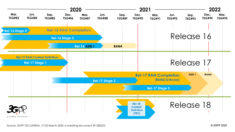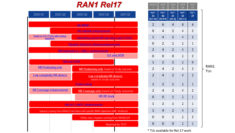Even though 3GPP Release 16 and Release 17 freeze dates have been moved back 3 months due to global events, there is still a good emerging picture of what 3GPP Release 17 specifications will tackle. Where the goal of Release 16 is to introduce standalone millimeter-wave 5G specifications, the focus of Release 17 is to expand the utility of cellular services to a variety of new applications. In essence, Release 17 is geared toward enabling new applications that service markets that would otherwise look to services outside of cellular.

Figure 1: 3GPP Release timeline. Source 3GPP.org
According to the current timeline, RAN1 work has already begun and will continue until Q1 of 2021. The main highlights of RAN1 work are described in Figure 2 from 3GPP.

Figure 2: Key technical areas of focus of the 5G physical layer. Source 3GPP.org
It is clear from the RAN1 physical layer goals, that there enhancements and studies targeting 5G NR capabilities that better serve the automotive and critical communications markets, i.e. the NR sidelink enhancements for which public safety applications should benefit. In general, Release 17 should lead to specifications that improve the efficiency of 5G NR, as well as the performance of MIMO. Other enhancement areas include dynamic spectrum sharing, user equipment power savings, and coverage. Release 17 is also targeted to extend the 5G NR specification to 71 GHz, possibly using the same waveform.
Further enabling Industrial IoT is also a planned goal of Release 17, with 5G NR positioning enhancements, and studies into low complexity NR devices. More IoT focused areas also include narrow-band IoT (NB-IoT) and enhanced machine-type communications (eMTC). Though it is unclear yet what these enhancements will entail, the obvious goals are to increase the capabilities in general, better support low latency applications, and otherwise better facilitate terrestrial Low Power Wide Area systems and Low Mobility Large Cell (LMLC) scenarios.
Other study areas include normative work on 5G NR enhancements that support non-terrestrial access (NTN), which includes satellites and High-Altitude Platforms (HAPs), such as Alphabet Inc., the parent company of Google, Project Loon (internet connectivity services delivered through a network of stratospheric balloons).
The next phase of Release 17 development has also already begun, Ran2 radio protocol enhancements. Efficiency and performance are top goals of the protocol enhancements, along with Multiradio dual-connectivity/carrier-aggregation (DC/CA), Integrated Access and Backhauling (IAB) development from the planned introduction in Release 16, small data transfer, further efforts toward user equipment power savings, and enhancements to self-organizing networks and minimization of drive tests (MDT).
It is also planned for Release 17 to support a new Multicast transmission feature, firstly focusing on single-cell multicast and later expanding to multi-cell Multicast. Efforts are also being directed to provide specification enhancements for Multi-SIM specifications, where prior Multi-SIM technology has been largely proprietary.
Lastly, RAN3 (Radio architecture enhancements) to support the features from RAN1 and RAN2 has also already begun in Q2 of 2020. Further efforts and the results of the study items will drive how Release 17 materializes, but Release 17 specifications are likely to be the biggest enabling factor for all of the hyped 5G technologies that have sounded more Sci-Fi than reality.
Resources
https://www.3gpp.org/specifications/releases
https://www.3gpp.org/news-events/2098-5g-in-release-17-%E2%80%93-strong-radio-evolution
https://www.3gpp.org/release-17
https://www.3gpp.org/DynaReport/21-series.htm




 Pasternack Blog
Pasternack Blog
